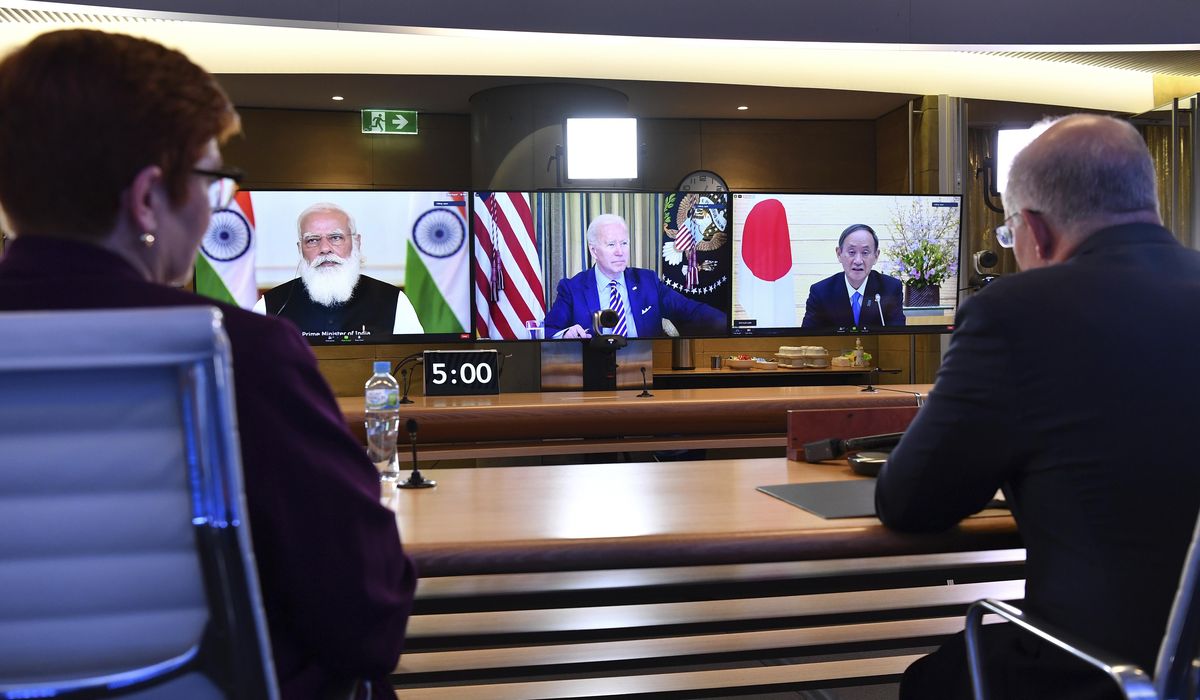
President Biden is preparing to host the first-ever in-person summit of leaders from the so-called “Quad” countries — the U.S., India, Japan and Australia — in a sign of growing momentum behind what began as a Trump-era push to rally Asia’s most powerful democracies into a more formal grouping to confront and contain communist China.
The Sept. 24 White House summit dovetails with this week’s announcement of a new U.S.-Australia-U.K. security pact that many see as a parallel effort to counter China. The administration’s embrace of the pact and promotion of the Quad underscores what analysts say is now an accelerating U.S. shift in focus toward the Indo-Pacific after decades of war and focus on terror groups in the Mideast and Afghanistan.
President Biden has largely picked up where former Trump administration officials left off with the Quad, embracing it as a central vehicle for the strategic shift, triggering in turn increasingly heated responses from Beijing. A Chinese Foreign Ministry spokesman insisted this week that the Quad is “doomed to fail” because its members are united by little other than the challenge they face from Beijing.
Regional experts, however, say there is no escaping the reality that U.S., Japanese, Indian and Australian strategic alignment is now openly and rapidly expanding in response to years of aggressive moves by China against democracy in Hong Kong and Taiwan, as well as by China’s growing economic and military clout both in the region and the world.
“This kind of cooperation among the Quad leaders, with a meeting at the White House, broadcasts clearly to China that it has a major challenge on its hands,” said Patrick Cronin, the Asia-Pacific security chair at the Hudson Institute in Washington.
Mr. Cronin said in an interview that he believes Chinese President Xi Jinping has encouraged the pushback by embracing an offensive foreign policy in recent years.
“One top of all of Xi’s other problems, including those he’s facing at home with the COVID-19 pandemic, he has now galvanized four leading maritime democracies to spearhead a political, economic and military alignment that can stand up to China’s provocations and coercion,” Mr. Cronin said.
“The fear that Taiwan could get whipsawed by China and that other regional actors, such as the Philippines and Vietnam, could be bullied by China has the Quad leaders wanting to help,” he said. “They want to do something about it to help insulate Southeast Asia from China’s bullying and coercion.”
“The point here,” he said, “is that perception of the ‘China threat’ has dramatically risen in the eyes of New Delhi, Tokyo, Canberra and Washington in recent years.”
China has responded with increasingly heated rhetoric since August 2020 when then-Deputy Secretary of State Stephen E. Biegun floated the idea that an informal U.S., Japan, Australia and India defense alignment could be the core of a NATO-style alliance in Asia.
Chinese Foreign Ministry officials have downplayed the notion, saying the Quad has no momentum. They’ve also accused the U.S. of trying to militarize the region and foment a confrontation with Beijing.
Chinese analysts say the four Quad countries come with very different agendas and challenges regarding China, with one comparing the Quad grouping to “four patients with different illnesses but stay in the same hospital ward.” Skeptics also note that China is the single biggest import and export market for Australia and Japan and the biggest foreign importer into the U.S. and Indian markets.
Gaining momentum
While Japanese Prime Minister Yoshihide Suga, Indian Prime Minister Narendra Modi and Australian Prime Minister Scott Morrison, will all coming to the U.S. for the U.N. General Assembly next week, the White House Quad meeting is likely to generate its own wave of international attention.
The grouping was first initiated back in 2007 by then-Japanese Prime Minister Shinzo Abe, although it struggled to gain major momentum as the U.S. and other powers still sought to engage with a rising China. Regional strategists say the landscape has been far more promising since the Trump administration put its weight behind the idea.
The Biden administration hosted a first-ever virtual leaders meeting of the Quad in March. Coming after a round of joint military exercises among the Quad nations, the meeting produced a joint statement in which the leaders vowed to coordinate closely on COVID-19 vaccine and climate initiatives.
They also pledged greater “collaboration” on “maritime security, to meet challenges to the rules-based maritime order in the East and South China Seas.” The language was a reference to frustration among many Asian nations, who view China’s aggressive sovereignty claims and its construction of military bases on artificial islands in disputed areas of the South China Sea as a violation of international law.
Since most countries in the region depend heavily on China for trade, few have been willing to fully break with Beijing.
The March Quad meeting spurred speculation that Washington may seek to establish an informal “Quad-plus” to include smaller nations on China’s periphery, including South Korea, the Philippines, Singapore, Malaysia and perhaps Vietnam.
While a senior administration official told The Times “there are currently no plans to expand the Quad by adding additional countries,” Mr. Biden’s top Asia policy adviser has openly sought to encourage others to “engage” with the grouping.
“This is not a fancy club,” Kurt Campbell, National Security Council coordinator for Indo-Pacific Affairs, told an online event hosted by Stanford University in May. “If there are other countries that believe that they’d like to engage and work with us, the door will be open as we go forward.”
Chinese officials are seen to be fuming at the notion. “China can retaliate economically if red line crossed,” a headline in the Chinese Communist Party-aligned Global Times warned ahead of the March Quad meeting.
This time around, Chinese Foreign Ministry spokesman Zhao Lijian argued that any anti-China grouping in the region was “doomed to fail.”
“Forming closed and exclusive ‘cliques’ targeting other countries runs counter to the trend of the times and deviates from the expectation of regional countries,” Mr. Zhao told reporters in Beijing on Tuesday when asked about the upcoming summit at the White House.
“It thus wins no support and is doomed to fail,” he claimed, asserting that “relevant countries should discard the outdated zero-sum mentality and narrow-minded geopolitical perception.”
“China is not only a major engine of economic growth in the Asia-Pacific, but also a staunch defender of regional peace and stability,” Mr. Zhao said.
Despite promoting the Quad, Biden administration officials have sought to avoid provocative rhetoric in public over the initiative. A White House statement announcing next week’s summit of Quad leaders made no mention of China.
“Hosting the leaders of the Quad demonstrates the Biden-Harris Administration’s priority of engaging in the Indo-Pacific, including through new multilateral configurations to meet the challenges of the 21st century,” the statement said. “The Quad leaders will be focused on deepening our ties and advancing practical cooperation on areas such as combatting COVID-19, addressing the climate crisis, partnering on emerging technologies and cyberspace, and promoting a free and open Indo-Pacific.”
Mr. Cronin, meanwhile, said he believes China’s expanding military activity near Taiwan — the island democracy that the communist government in Beijing has long claimed sovereignty over — is likely also to be on the agenda.
“I think we’re going to see this dimension about peace and security in the Taiwan Strait, maritime security and defense technology cooperation, both through joint exercises and through research and development projects,” he said. “It’s just further augmentation of the defense dimension of the relationship.”







